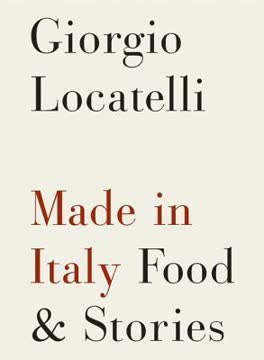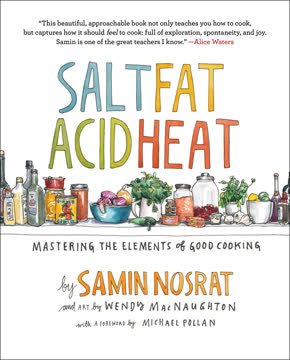Key Takeaways
1. Conviviality: The Heart of Italian Food
At the heart of all cooking, whether you are rich or poor, is the spirit of conviviality, the pleasure that comes from sharing a meal with others.
Sharing and connection. For Giorgio Locatelli, Italian food is fundamentally about bringing people together, fostering conversation, and creating shared experiences. It's a profound sign of welcome, a daily drama where everyone has an opinion, and a cherished moment to relax and interact. This philosophy, deeply rooted in his childhood at La Cinzianella, extends to his own restaurant, Locanda Locatelli, where he strives to create a special, familial bond with his customers.
Antipasti as a ritual. The tradition of antipasti perfectly exemplifies this spirit, serving as a signal to unwind and engage. Unlike individual starters, antipasti are meant to be passed around, encouraging interaction, generosity, and discussion. Locatelli recalls the shock of encountering tiny, individual canapés in French restaurants, contrasting them with the Italian desire to share abundant, simple offerings.
Beyond sustenance. Eating, for Locatelli, transcends mere sustenance; it's about friendship, celebration, and a deep personal connection. He values customers who return for anniversaries or birthdays, inviting their children into the kitchen, fostering an intimacy that makes his restaurant an extension of his family. This ethos ensures that every meal is a memorable event, steeped in warmth and shared joy.
2. Ingredient Quality is Paramount
And there is no enjoyment of food without quality.
Foundation of flavor. Locatelli unequivocally states that quality ingredients are the non-negotiable foundation of delicious food. He passionately champions the Slow Food movement, which originated in Italy, for its emphasis on local, traditional produce with real flavor, cultivated by caring people with skill and wisdom. This commitment to quality ensures that the inherent taste of the food shines through.
Conscious choices. He urges consumers to make responsible choices, investing in small farms and dairies rather than solely relying on supermarkets that often prioritize perfect appearance and cheapness over genuine flavor and ethical sourcing. Every purchase, he argues, has consequences, and consumers have the power to support producers who uphold high standards.
Protected designations. To guide consumers, Locatelli highlights the importance of DOP (Denominazione di Origine Protetta, or Protected Designation of Origin) and IGP (Indicazione Geografica Protetta, or Protected Geographical Indication) labels. These symbols guarantee that products like Parmigiano-Reggiano or prosciutto di Parma are produced in designated areas using specific, traditional methods, ensuring authenticity and superior quality.
3. Embrace Simplicity and Regionality
It is better to buy primary ingredients that have their own fantastic flavor and then you have to do less with them.
Less is more. Locatelli advocates for simplicity in cooking, believing that fantastic ingredients require minimal intervention. The goal is to amplify the natural taste of the primary ingredient, rather than complicating it with too many competing flavors. This philosophy allows the inherent quality of the produce to be the star of the dish.
Regional diversity. Italy's diverse geography and rich history have fostered unique regional cooking styles, each fiercely proud of its traditions. This leads to distinct ingredients and preparations, from the delicate seafood and tomatoes of the hot south to the warming polenta, risotto, and cured meats of the cooler north. Locatelli notes that "in every region, town and village, they have their own particular ingredients and style of cooking, which of course they will insist is absolutely the right way."
Reinterpreting classics. While deeply respecting tradition, Locatelli also embraces the reinterpretation and updating of classic dishes to suit modern palates and restaurant environments. However, this adaptation always ensures that the essential flavors and combinations remain rooted in authentic regional Italian cooking, maintaining a balance between heritage and innovation.
4. Master the Fundamentals of Italian Cooking
If you understand a few basic principles, you can appreciate the difference between a plate of something that is okay and something that is truly fantastic, in which the sauce and pasta are no longer two separate things, but become one entity, in which every surface and nook and cranny of pasta is coated and saturated with flavor.
Core techniques. Locatelli emphasizes that understanding fundamental cooking principles transforms a dish from merely "okay" to "truly fantastic." This includes mastering basics like making flavorful stocks, precise seasoning, and the nuances of cooking pasta and rice to perfection. These foundational skills are the bedrock of authentic Italian cuisine.
Risotto and pasta perfection. For risotto, the "mantecatura" (beating in cold butter and cheese at the end) is crucial for achieving that gorgeous, loose creaminess, or "all'onda." For pasta, achieving "al dente" (firm to the bite) and finishing it in the sauce with some reserved cooking water ensures perfect amalgamation, allowing the sauce to cling to every strand and nook.
Beyond recipes. These techniques are not just steps to follow but a deep, intuitive understanding of how ingredients interact. Locatelli's journey, from his grandmother's kitchen to Michelin-starred restaurants, highlights continuous learning and adaptation of these core skills, emphasizing that true mastery comes from feeling the food.
5. Food as a Cultural Narrative
I am a great believer in the idea that – as much as art or literature or poetry – cured meats are truly representative of the cultural background of society; they are the voice of the people, and have been over hundreds of years.
Edible history. Locatelli views food, particularly traditional dishes and ingredients like cured meats, as a living history. They tell the story of Italy's diverse regions, its people, and centuries of adaptation to local produce and microclimates. Each product is a testament to ingenuity born from necessity.
Regional identity. From the lightly smoked speck of the cooler, rainier north to the sun-drenched tomatoes and delicate seafood of the hot south, food embodies distinct regional identities. These identities are shaped by historical influences—Spanish, French, Austrian—and the unique geographical variations across the Italian peninsula. Locatelli notes the stark differences between the industrial north and the idyllic south.
Personal connection. Locatelli's personal anecdotes, such as his grandmother's cooking, the "five faces" michetta bread, or the annual truffle hunt with his granddad, illustrate how food is deeply intertwined with personal memories, family traditions, and a profound sense of belonging. Food is not just sustenance; it is identity, memory, and community.
6. The "Soul" of Pasta and Rice
If the durum wheat is picked at the right time, handled well and dried correctly, and if you cook the pasta for the right length of time, then the outer layer of starch will dissolve and be released into the water, but that “chain” will stay intact in the middle of the pasta. This is its “soul.”
Al dente perfection. The "soul" of pasta, according to Locatelli, is the unbroken protein chain in its core, which gives it the desired "al dente" bite. This is achieved through using high-quality durum wheat, proper drying processes, and precise cooking. The outer starch softens and emulsifies with the sauce, while the inner core retains its firm texture.
Risotto's creamy bite. Similarly, risotto rice (japonica varieties like Carnaroli or Vialone Nano) is composed of two starches: amylopectin on the surface for creaminess and amylose in the kernel for structure. The slow, continuous stirring and gradual addition of hot stock are crucial for releasing the surface starch without breaking the grains, resulting in a creamy yet al dente risotto.
Beyond mere carbs. For Italians, pasta and rice are not just vehicles for sauce; they possess their own distinct flavors and textures. The choice of pasta shape is crucial, as it dictates which sauces will cling best, creating a unified, flavorful dish. Locatelli laments "fast cooking" spaghetti and overly processed pasta, emphasizing that quality and proper technique are paramount for these staples.
7. Respect for the Whole Animal
I really believe we should eat everything from an animal; it doesn’t make sense to eat only fillets and steaks, which make up only a small percentage.
Nose-to-tail philosophy. Locatelli passionately advocates for utilizing every part of an animal, a tradition born from necessity in poorer rural communities. This "nose-to-tail" approach fosters deep respect for the animal and minimizes waste, contrasting sharply with modern preferences for only prime cuts. He recalls his childhood, where every part of a pig or chicken was used.
Offal's hidden value. Dishes using offal, or "variety meats," like brains, sweetbreads, kidneys, and feet, are celebrated in Italy for their unique flavors and textures. Often transformed into memorable, tender dishes through careful preparation, they represent a culinary heritage that values resourcefulness and taste over squeamishness. Locatelli highlights dishes like finanziera (chicken offal stew) and fritto misto (mixed fried morsels).
Support local butchers. Maintaining a proper connection to where meat comes from and how it's raised is vital. Locatelli emphasizes supporting quality butchers who prioritize traceability, ethical farming, and traditional hanging methods over cheap, mass-produced alternatives. He believes this ensures better flavor, tenderness, and a more wholesome product, urging consumers to question the true cost of cheap meat.
8. Desserts: Simple Pleasures & Seasonal Delights
The rhythm of a traditional Italian meal, with its risotto or pasta course, has enough carbohydrate highs without needing anything elaborate to follow, so the typical Italian dessert repertoire tends to be more humble than that of other cultures.
Humble endings. Traditional Italian meals often conclude with simple fruit, reflecting a natural balance after rich pasta or risotto courses. Elaborate cakes and pastries are typically reserved for special occasions, religious festivals, or enjoyed in cafes and pasticcerie (pastry shops), rather than as a standard meal finale.
Seasonality of fruit. Locatelli emphasizes the profound importance of seasonal, locally grown fruit, picked ripe for maximum flavor. He laments the trend of unripe, flavorless supermarket fruit, advocating for appreciating nature's rhythm and the unique taste of fruit at its peak. He recalls the joy of fresh figs, peaches, and grapes from his childhood.
Ice cream's Italian roots. Italy is the undisputed home of ice cream (gelato and sorbetto), a sophisticated science of balancing sugars and fats to achieve perfect texture without crystallization. Locatelli highlights the meticulous process behind seemingly simple frozen delights, contrasting it with the often-oversweetened commercial versions found elsewhere. He also shares the historical significance of ice and snow in ancient Roman and Chinese cultures.
9. The Chef's Journey: Passion, Learning, and Adaptation
Everything I have done in my life is reflected in my food, though it is hard for me to say exactly what I took from my time studying French cooking at the Savoy and in Paris.
Formative experiences. Locatelli's culinary journey began in his grandmother's kitchen in Corgeno, instilling a deep respect for ingredients and conviviality. Early experiences, like finding Giovanni's "Savoy, London" suitcase and Michele's chef jackets, fueled his ambition to travel and cook, shaping his identity as "Houdini" – the great escapist.
French influence. His time at the prestigious Savoy in London and in Paris (Le Laurent, La Tour d'Argent) introduced him to French precision, elaborate techniques, and meticulous attention to detail. This period, though challenging, taught him the importance of consistency, measurement, and the art of refined presentation, which he later integrated into his Italian cooking philosophy.
Finding his voice. Returning to London, Locatelli sought to combine Italian spontaneity and flavor with French refinement. This led to the creation of Olivo and later Zafferano and Locanda Locatelli, where he could express his unique culinary identity. He learned to balance menus, prioritize customer experience, and continuously adapt, always driven by a passion for food and a desire to surprise and excite.
10. The Fight for Authenticity in Food
As always with food, you have to ask not “Why is one product so expensive?” but “What has been done, or not done, to the alternative product that makes it so cheap?”
Questioning cheapness. Locatelli challenges consumers to critically evaluate cheap food, arguing that low prices often come at the expense of quality, ethical production, and health. He highlights issues like bleached wheat, rapid drying processes, and artificial additives in mass-produced pasta, which compromise flavor and nutritional value.
Protecting heritage. He passionately advocates for stricter regulations and consumer awareness to protect authentic Italian products like DOP cheeses, olive oil, and pasta from imitations and industrial shortcuts. He believes it's crucial to safeguard Italy's "terroir" and the integrity of its culinary heritage against the pressures of commercialization.
Beyond profit. The true value of food, for Locatelli, lies not just in its taste but in its story, its connection to the land, and the care taken in its production. His work is a continuous effort to preserve this integrity, ensuring that every dish served reflects a commitment to quality, tradition, and the well-being of both people and the planet.
Last updated:
Review Summary
Made in Italy is highly praised for its authentic Italian recipes, personal stories, and culinary insights. Readers appreciate Locatelli's passion, detailed explanations, and emphasis on quality ingredients. The book is described as part cookbook, part memoir, offering a deep dive into Italian food culture. While some find the recipes labor-intensive, many consider the results worth the effort. Readers especially enjoy the sections on risotto, pasta, and traditional techniques. Despite minor editing issues, the book is widely regarded as an essential resource for Italian cooking enthusiasts.
Similar Books
Download PDF
Download EPUB
.epub digital book format is ideal for reading ebooks on phones, tablets, and e-readers.









